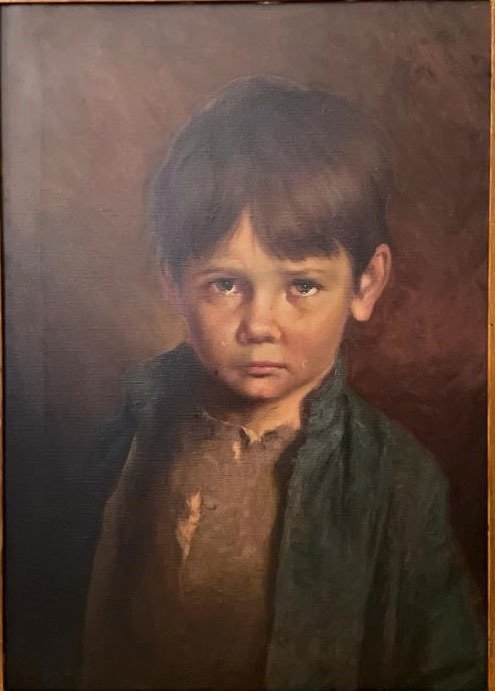
H. Sanders (XX) - Omgeving Krimpen aan den IJssel
Nr. 47413871

Nr. 47413871

GIOVANNI BRAGOLIN (1911-1981)
"bambino"
Oil on canvas.
Beautiful oil on canvas representing a crying kid.
Very realistic and high quality expression.
It is signed on the upper right hand side, it is in good condition.
Together with the painting, the purchase invoice and the gallery catalogue are delivered.
Dimensions: Height: 50 x Width: 70 cm
Dimensions with frame: Height: 88 x 71 cm
Bruno Amadio (Venice, Italy, January 15, 1911 - Padua, Italy, September 22, 1981), better known as Angelo (Giovanni) Bragolin, Franchot Seville, J. Bragolin (if the signature is misread in his paintings) or the Cursed Painter, was an Italian painter settled in Spain after the Second World War. He is credited with a series of twenty-seven portraits known as the “Niños llorones” (crying children).
The black legend that surrounds him says that his paintings attracted misfortunes to those who owned them. However, they have been works of great dissemination, being highly sought after their reproductions in countries such as Spain or England.
There are few details of his life that have accurate information.
He was born in Venice, Italy, on January 15, 1911. He was a painter and studied the plastic arts academically, although later he developed his own technique, brushstroke and style. It is said that in his youth he adhered to fascism. He also entered into a relationship with futuristic plastic artists, led by Filippo Tommaso Marinetti. During this artistic period, Amadio painted a picture that portrays a beautiful and graceful woman shooting an arrow with a bow, which could have been painted in 1941.
Apparently, Bruno Amadio was mobilised as a soldier in the Italian Army during World War II. During this experience he saw the suffering of children in various villages and cities because of the conflict. This anguishing image would split the artist's sensitivity and would later significantly mark his work.
After the war, he went to Spain and settled in the city of Seville. Later he apparently resided in Madrid.
Right there he would begin to use the pseudonym Giovanni Bragolin to sign his paintings, the well-known portraits of “Niños llorones”, which show images of boys and girls in the foreground on the face and bust, with a sad gesture with large and visible tears running down their faces. These paintings were later reproduced on sheets of paper and panels, having a wide commercialisation in many countries of the world, especially during the 1970s and 1980s.
Amadio also painted still lifes in the academic style. These works include a series of figurative-realistic still lifes, with a certain 17th-century style, in which the contrasts of light and sfumatos in shades give an idea of the possible original academic training of the artist. The motifs that appear in his well-known still lifes are usually fruits and books. In both paintings a great dose of realism is observed, some effects of the reflection of the fruits on a spotlessly varnished table; a letter and a photograph in one of them, and a sample of the great talent of the painter when it comes to playing with light and shadow. Apparently, one of them could be dated 1967.
Bruno Amadio returned to Italy in the 1970s and settled in a villa in the city of Padua. Some claimed that for some time he painted pictures for tourists in this city and also in Florence. In 1979 he continued painting, according to testimonies. Bruno Amadio died in Padua on September 22, 1981.
Like other paintings, such as The Scream by Edvard Munch, the works of this painter have transcended the possible pictorial fact. The great expressiveness and symbolism they reflect, emanated from the author's sensitivity influenced by the social events of the moment, have led to the creation of fables that have never been corroborated.
Hvordan kjøpe på Catawiki
1. Oppdag noe spesielt
2. Legg inn det høyeste budet
3. Å gjøre en sikker betaling